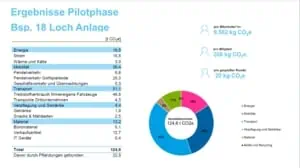CO2 calculator determines key points for more climate protection
What does the carbon footprint of an average golf course look like, and what can be learned from the calculated figures?
This question dominated the summary of the pilot project CO₂ calculator for golf courses, which the Bavarian Golf Association carried out in recent months with the company MyClimate and five courses. The interesting thing about this is that since there is no generally valid CO₂ calculator internationally or even in Germany that would enable international benchmarking, the pilot project also meant an initial development of a possible process for golf courses. According to Alina Feucht from MyClimate, the following results are essential:
- “The area Scope 3 is generally one of the biggest sources of CO₂ in sport. It would be fatal to neglect it.” This therefore also applies to golf. The results of the golf courses show that Scope 3 in particular, with the entire sector mobility of golfers is the biggest hotspot in the analysis.
- Data collection for the golf courses proves to be the biggest stumbling block in the first year of a CO₂ analysis. According to Feucht, experience with Bundesliga clubs in soccer or ice hockey, but also in other sports, shows that this is the case everywhere.
- The pilot project resulted in a CO2e value of between 124 tons and 238 tons for the five participating Bavarian golf courses. The value per round of golf varied between 10 and 20 kg CO2e. “However, comparability is only possible to a very limited extent, and it is still too early for benchmarking,” Feucht concludes. Instead, the participating clubs now need to build on the results and incorporate climate protection into their own business practices.
Looking at the results, however, it is certainly possible to identify to-dos for the golf courses. “At the end of the day, it’s all about getting better,” said Korbinian Kofler, Managing Director of Wittelsbacher Golf Club, “even if that just means installing electricity meters in the greenkeeping area.” This point was also one of the experiences of the pilot project: it was not always possible to break down electricity and heat consumption precisely into the individual areas of the golf course.
“Now we simply have the figures in front of us and can work with them,” confirmed Bernd Dürrbeck, President of GC Herzogenaurauch. “I think it’s cool that you can now see exactly what’s going on and that you can be guided by this when the Board of Directors makes its next decision on construction projects or investments.” New purchases for the vehicle fleet or greenkeeping can now be considered from a climate perspective.
When it comes to mobility, many golf courses clearly doubt their capabilities. How, is a frequently asked question, can the management or board of a golf course influence player mobility? “It is important that you take the community with you and create attractive incentives,” Feucht noted. The formation of car pools on tournament match days is just one step in the right direction.
According to MyClimate, which is also implementing CO₂ calculators and projects with the Deutsche Fußball Liga and the Deutsche Eishockey Liga, the start of CO₂ recording is therefore a very positive point for the golf sector: “The requirement for the individual club is not to do something perfectly, but to deal with the topic at all.”








